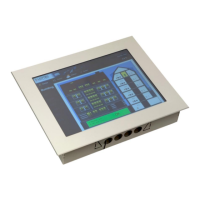L-VIS User Manual 145 LOYTEC
Version 6.2 LOYTEC electronics GmbH
NOTE: The value translation of a data point can be very useful to modify a value on its way
between a data processing object and a register or network value. Using this facility,
simple data manipulation like the inversion of a state or the addition or subtraction of a
fixed offset can be archived without using a separate math object. For example, an action
which toggles a light switch may be implemented by assigning the inverted feedback input
(current switch state) to the control output. The inversion is done with DP=-1*NV+1.
The Details section shows details of the referenced data point, like the name of the
underlying network object, the network object type, units, and other information. Also
shown is the unique ID of the referenced data point, by which the point may be located in
the data point management window for further inspection or modification.
In the Data Point Update Flags section, the value update mode is specified. There are three
basic modes available, together with some additional options:
No Update: This means that this data point object will not request the referenced
data point to be updated on the network, even when the value on the control side
changes. Useful if this data point object references one element of a structured
data point, and updates to this element should not cause the top level data point to
be transmitted on the network.
Focus Loss: This update mode transmits the new value only when the input
control returned focus and left input mode, that is, when the final value is known.
Intermediate values, which are for example generated by moving the bar of a bar
control around, are not immediately transmitted. Use this option for push button
mode (see section 9.5.3 for more information).
Immediate: All values are immediately transmitted to the referenced data point.
This provides direct feedback to the user, while the control is still in input mode
and the user is still modifying the value. Currently really only useful for bar
controls and controls which use the keypad, since the keypad has + and – keys,
which send out intermediate values.
System Startup: The checkbox System Startup should be checked to instruct the
device to update the value on system startup. If the option is set on an output data
point, the default value or the last stored value will be sent out. If it is used on an
input data point, the current value will be requested from the underlying data
point layer and if available, will be received and processed like a normal value
update. See also Section 9.6.2 for details about updates on system startup.
Value Changes Only: This option causes the data point to forward updates only
if the value actually changed. It is very useful to avoid unnecessary operations
caused by repeated updates with the same value, provided that the data point does
not represent an event, in which case all updates must be processed and this
option should not be used.
No Invalid Updates: This option causes the data point to filter out updates which
set the value invalid (for example because the value cannot be determined from
the network). Normally the invalid state is passed on to the other side. If this
option is checked, the update is not forwarded, so that there is no change to the
current value.
Map Invalid to Default: This option causes the data point to map invalid
updates to the default value specified in the Default field. This is useful for input
data points which may be unavailable (for example not bound) and this situation
is not considered an error. Using this option, unavailable data can be replaced by
a safe default. If the invalid state would be forwarded and the value would be
used in a calculation, the entire result of the calculation would become invalid,
which may not be desired.

